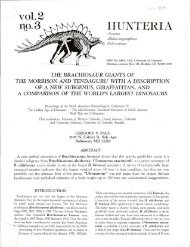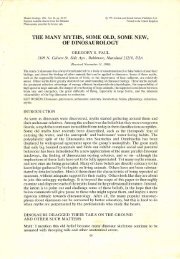Case 3506 Allosaurus Marsh, 1877 (Dinosauria ... - Gregory S. Paul
Case 3506 Allosaurus Marsh, 1877 (Dinosauria ... - Gregory S. Paul
Case 3506 Allosaurus Marsh, 1877 (Dinosauria ... - Gregory S. Paul
You also want an ePaper? Increase the reach of your titles
YUMPU automatically turns print PDFs into web optimized ePapers that Google loves.
54 Bulletin of Zoological Nomenclature 67(1) March 2010<br />
et al., 2006). The probability that this theropod genus consisted of a number of<br />
species preserved as a large and variable set of remains over a wide span of time and<br />
geographical area reinforces the requirement that the type species be based on a high<br />
quality specimen that provides the foundation for a detailed diagnosis.<br />
4. Because a tooth, a pair of dorsals and a toe element are inadequate to diagnose<br />
a genus, much less a species, YPM 1930 can only be identified to family level. The<br />
same problem afflicts all specimens that potentially represent the same late Jurassic<br />
allosaurid genus from western North America. From the same Quarry 1 as YPM<br />
1930, Labrosaurus ferox <strong>Marsh</strong>, 1884 (p. 333) is another nomen dubium because the<br />
holotype USNM 2315 is a peculiar dentary with apparent pathologies that further<br />
obscure its generic and specific status. Specimen YPM 1931, the holotype of<br />
<strong>Allosaurus</strong> lucaris <strong>Marsh</strong>, 1878 (<strong>Marsh</strong>, 1878, p. 242) from the middle Morrison<br />
Formation of southern Wyoming, consists of some presacral vertebrae and pectoral<br />
and forelimb elements. It is significantly younger than YPM 1930, probably<br />
represents a different species from YPM 1930, and may or may not belong to the<br />
same genus. It is not sufficiently complete to characterise a species. The name<br />
<strong>Allosaurus</strong> lucaris is therefore also a nomen dubium. Antrodemus Leidy, 1870, type<br />
species Poicilopleuron valens Leidy, 1870 (p. 4) is based on holotype USNM 218<br />
(posterior half of the centrum of a proximal caudal) from northern Colorado.<br />
Because USNM 218 is entirely inadequate as a holotype in terms of quality and<br />
provenance, Antrodemus is a nomen dubium (Madsen, 1976; <strong>Paul</strong>, 1988; Glut, 1997;<br />
Holtz et al., 2004), and is no longer used by current researchers. Epanterias amplexus<br />
Cope, 1878 (Cope, 1878a, p. 406) comes from the much younger upper Morrison<br />
Formation at Garden Park, and is probably a different taxon from YPM 1930. It is<br />
a nomen dubium because holotype AMNH 5767, consisting of a few vertebrae, a<br />
pectoral element and a limb bone, is insufficiently diagnostic. Also unsatisfactorily<br />
diagnostic is the holotype of Creosaurus atrox <strong>Marsh</strong>, 1878 (<strong>Marsh</strong>, 1878a, p. 243),<br />
YPM 1890 from the middle Morrison Formation of southern Wyoming. It consists<br />
of two skull elements, two sacrals, and a few pelvic and limb elements, and is a nomen<br />
dubium. Hypsirophis discursis Cope, 1878 (Cope, 1878b, p. 389), is a nomen dubium<br />
because the holotype AMNH 5731 is a neural spine. The holotype of <strong>Allosaurus</strong><br />
europaeus Mateus, Walon & Antunes, 2006 (p. 128), ML 415, is the posterior half of<br />
a skull. Although marginally diagnostic, ML 415 may or may not belong to the same<br />
genus and species as, and be contemporary with YPM 1930, and the two individuals<br />
lived some 4000 km apart. All of the above taxa and type specimens are large<br />
allosaurid remains, all far too incomplete to be determinate, but broadly contemporary<br />
with, and potential synonyms of A. fragilis which itself is based on nondiagnostic<br />
remains.<br />
5. The genus <strong>Allosaurus</strong> continues to be in use despite the absence of an adequate<br />
type specimen for its type species because <strong>Allosaurus</strong> fragilis is tacitly diagnosed on<br />
the basis of two nearly complete and well described skulls and skeletons: USNM 4734<br />
(Gilmore, 1920) is from the same Garden Park quarry as YPM 1930 (Evanoff &<br />
Carpenter, 1998); it was erroneously referred to as a paratype of A. fragilis by<br />
Madsen (1976, p. 10). Madsen’s (1976, p. 10) neotype designation of the even more<br />
complete DINO 2560 (National Monument Collection, formerly UUVP 6000<br />
(University of Utah Vertebrate Paleontology)) is invalid as the original type material<br />
is extant (Article 75.1 of the Code), and does not comply with Article 75.3.6 of the









